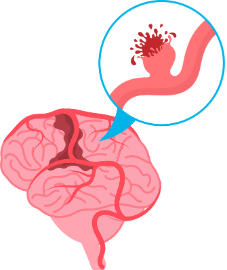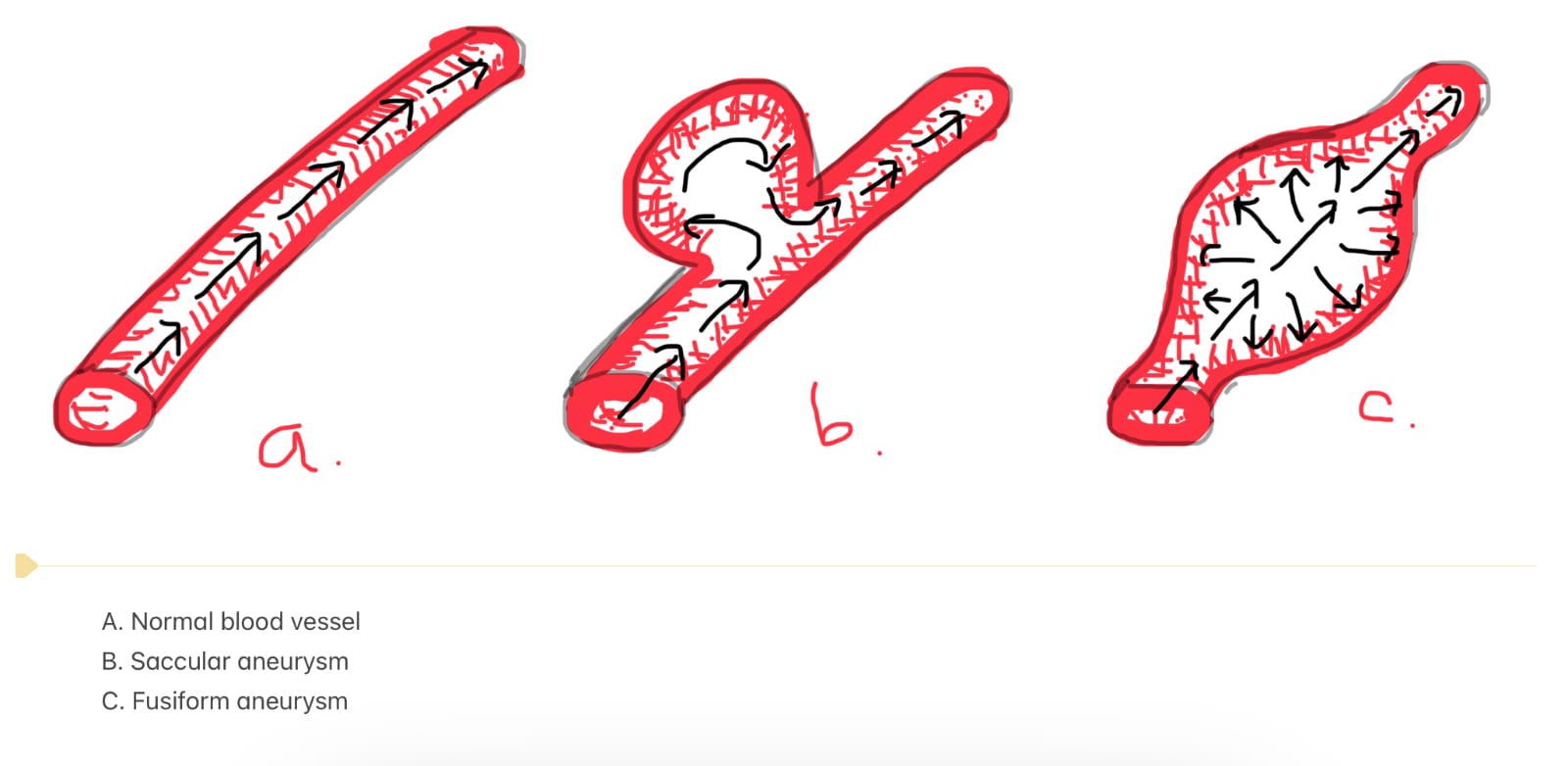Blog | Specialized Care
Cerebral Aneurysms: The Time Bomb in Our Brains
published: 5/13/2025
viewedby 379 visitors
Introduction
Cerebral aneurysms are a ballooning or bulging of the brain’s arterial blood vessels caused by a weak point in the vessel’s wall. Over time, cerebral aneurysms may enlarge and reach a critical point where they will rupture and cause subarachnoid hemorrhage, a type of hemorrhagic/bleeding stroke. It is, literally, a time bomb in our brains, waiting to explode should proper preventive and curative measures not be taken.

1. Epidemiology
Accounting for the 2023 global population, unruptured cerebral aneurysms are estimated to affect 3.2% of the population, which equals + 262 million out of 8.2 billion people, or 3,200 per 100,000 people.
Of these,
- 0.3% will rupture at least once in a lifetime, i.e., in 10 per 100,000 patients; and
- One brain aneurysm ruptures every 18 minutes.
Although the number of ruptured cerebral aneurysm cases may look small:
- + 50% of cases will be fatal
- +15% of patients will die before ever reaching the hospital
- +50% of patients will die within 24 hours of rupture
- +50% of patients will succumb to death within three months due to complications
These statistics are real and highlight the importance of properly managing unruptured and ruptured cerebral aneurysms.
2. Symptoms & Signs
Unruptured cerebral aneurysms
Unruptured cerebral aneurysms may be without any symptoms or signs. They are commonly discovered as incidental findings during medical check-ups or radiological examinations for other neurology-related conditions. They may grow to be large enough to cause multiple mass-effect related symptoms or signs, such as:
- Mild headache
- Blurry vision
- Slight facial/body numbness/weakness
- Seizure
Ruptured cerebral aneurysms
The hallmark symptom of a ruptured cerebral aneurysm is a ‘thunderclap’ headache, a sudden and severe headache which some describe as the worst headache of their life. Other symptoms and signs may include:
- Seizure
- Nausea and vomiting
- Blurry/double vision/photophobia (oversensitivity to light)
- Facial/body numbness/weakness
- Loss of consciousness
Without proper and timely management, ruptured cerebral aneurysms may worsen and cause life-threatening complications, such as:
- Intracerebral hemorrhage: bleeding inside the brain tissue
- Intraventricular hemorrhage: bleeding inside the ventricles, the brain’s sewer system to circulate and drain cerebrospinal fluid
- Hydrocephalus: an accumulation of cerebrospinal fluid within the ventricles
- Electrolyte imbalances, especially sodium
- Vasospasm: narrowing of cerebral blood vessels, causing ischemia and death
3. Types
Shape-wise, there are three types of cerebral aneurysms:
- Saccular/berry: the most common, resembling berries hanging from its branches
- Fusiform: ballooning on all sides of the arteries
- Mycotic: arterial bulging due to infection

Size-wise, there are also three types of cerebral aneurysms:
- Small: diameter <11 mm
- Large: diameter 11-25 mm
- Giant: diameter >25 mm
4. Risk factors
Several risk factors might predispose someone to develop an aneurysm, such as:
- Age: most common in the 3rd-6th decade of life
- Sex: females, especially after menopause, have a greater risk than males
- Race: Finnish or Japanese descendants have a higher risk than other races
- Family history: chromosome 9p21 has been linked with intracranial aneurysm
- Unhealthy lifestyle: smoking (conventional/electronic/vaping), high alcohol intake
- Other conditions: high blood pressure/hypertension, high cholesterol/hypercholesterolemia, diabetes, connective tissue disorders
Moreover, there are a number of risk factors that may increase the risk of rupture:
- Size
- Shape
- Growth rate
- Previous ruptures
- Family history of aneurysm ruptures
5. Diagnosis
Cerebral aneurysm is diagnosed through meticulous investigations of symptoms and signs, as well as these examinations:
- Brain computed tomography (CT) scans, both non-contrast and CT angiography (CTA), especially in the acute phase
- Brain magnetic resonance (MR) imaging
- Cerebrospinal fluid (CSF) analysis
- Digital subtraction angiography (DSA)
6. Management
Proper management will depend on the nature of the aneurysm.
Unruptured cerebral aneurysms
Treatment for unruptured cerebral aneurysms is focused on assertively reducing or eliminating rupture risks and carefully choosing definitive procedures to prevent aneurysm rupture, e.g.,:
- Surgical clipping: placing sufficient clip(s) to obliterate the aneurysm via opening of the skull and the dura mater
- Endovascular coiling: placing coils to fill the aneurysm and eliminate any remaining space via radial or groin catheter
- Endovascular flow diverter: placing stent(s) to divert blood flow from the aneurysm, thus inducing aneurysm thrombosis and shrinking
Ruptured cerebral aneurysms
Besides the procedures mentioned above, the following procedures might be performed to manage the complications of ruptured cerebral aneurysms:
- Endoscopic/craniotomy hematoma evacuation: surgery to remove a blood clot inside the brain that may be performed using open craniotomy or endoscopy instruments
- Decompressive craniectomy: surgery to remove pressure building from within the skull
- Ventriculoperitoneal shunt/external ventricular drainage: drainage of the accumulated cerebrospinal fluid from within the ventricles to release pressure
7. What to do when you experience/witness others experiencing the symptoms/signs of unruptured/ruptured cerebral aneurysms?
Please go directly to the nearest health care facility with the proper resources to manage cerebral aneurysms (neurologists and/or neurosurgeons present, 24-hour catheterization lab and operating theaters). Do not waste time. Each second matters.
8. References
Brain Aneurysm Foundation, https://www.bafound.org
Jersey AM, Foster DM. Cerebral Aneurysm. [Updated 2023 Apr 3]. In: StatPearls [Internet]. Treasure Island (FL): StatPearls Publishing; 2025 Jan-. Available from: https://www.ncbi.nlm.nih.gov/books/NBK507902/
NIH National Institute of Neurological Disorders and Stroke, Cerebral Aneurysms, https://www.ninds.nih.gov/health-information/disorders/cerebral-aneurysms
about_author
Dr. Aryandhito Widhi Nugroho, M.D., Ph.D

Neurosurgeon, Bali International Hospital
Dr. Aryandhito Widhi Nugroho, Ph.D., is a highly accomplished neurosurgeon with a robust academic and clinical background. He earned his Neurosurgery degree from Universitas Indonesia in 2020, complemented by a Doctor of Philosophy (Ph.D.) from Shiga University of Medical Science in Japan, completed in 2018. His medical journey began with an M.D. from Universitas Indonesia in 2007, laying the foundation for his expertise in advanced neurosurgical techniques. In addition to his clinical roles, he also serves as an lecturer and researcher at the Faculty of Medicine, Khairun University, North Maluku. Fluent in both English and Indonesian, Dr. Dhito is committed to delivering exceptional patient care while contributing to the development of future medical professionals. His international training and diverse experiences make him a key figure in the field of neurosurgery in Indonesia.